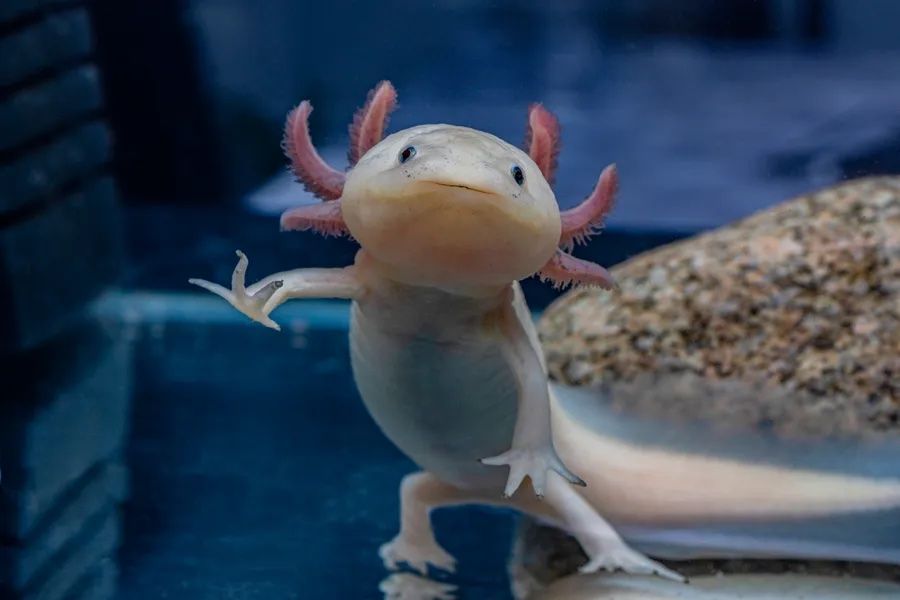axolotls are critically endangered. According to the IUCN Red List of Threatened Species, these aquatic monsters—a national symbol that features on Mexico’s 50 peso bills, and which were once considered divine entities, the “twins” of the Aztec deity Quetzalcoatl—are at “extremely high risk of extinction in the wild.”
The figures tell it best. In 1998 there were 6,000 axolotls per square kilometer in their natural habitat, the district of Xochimilco in the south of Mexico City. By 2004, that figure had fallen to just 1,000, and by 2008 it was only 100. A 2014 census of Mexico’s wild axolotl population found only 36 of the creatures. Now, a decade later, a new survey is underway. Xochimilco is home to the remnants of a vast canal network built by the Aztecs, and is a UNESCO World Heritage Site, though the district is facing ecological deterioration as a result of increasing urbanization.
Everything indicates that for the axolotl, the countdown to extinction continues. But there is one last hope. Scientists from the Ecological Restoration Laboratory at the National Autonomous University of Mexico (UNAM), who are in charge of the axolotl census, are seeking to reverse this trend and conserve one of the oldest terrestrial vertebrates on the planet.
“The objective of the census is to know the current status of the axolotl population,” says Luis Zambrano, project leader and founder of the Ecological Restoration Laboratory. Public sightings are important, he says, but to be sure of their existence in the wild, there needs to be evidence. Armed with confirmation that axolotls are still present in Xochimilco, and with an estimate of how many, the researchers then plan to run campaigns to combat misinformation about the species and to guide conservation, and also to bolster the wild population by releasing reared individuals. The final results of this survey will be published in the first half of 2025, and a new count is planned for 2026.
WIRED witnessed firsthand how scientists Vania Mendoza, Viviam Crespo, and Paola Cervantes—together with local villagers, like Basilio Rodríguez—conducted the census. They used traditional fishing techniques together with innovative methods such as environmental DNA analysis, where a species can be traced by hunting for DNA that it sheds into its surrounding habitat.
The surveying takes place at dawn in Xochimilco, one of the last vestiges of the ancient lake system of the Basin of Mexico, where plant and animal species that modernity has erased from other parts of Mexico City still survive. It’s a magical oasis in the monster capital that looks like something out of a Mexican fairy tale, where herons and pelicans are heard as the sun comes up. As we travel through the landscape on a wooden raft, we see that the lake is still filled with chinampas, artificial agricultural islands first developed in pre-Hispanic times and which amazed the first Spaniards who came to these lands.
The axolotl has four legs, a long tail, and is nocturnal and carnivorous. They appear in four different colors: wild axolotls have a blackish-brown hue, while mutant variants include leucistic (white with dark eyes), white albino, and golden albino. “So far, we haven’t found any axolotls; however, DNA analysis offers a chance,” says Paola Cervantes, a graduate in earth sciences and part of the UNAM team for this year’s census.
Meanwhile, Basilio Rodríguez, a former fisherman and farmer from the area, prepares his homemade cast net and looks for signs of the amphibian. “They breathe every five minutes,” Rodríguez explains. “When they come up to breathe, it makes a kind of ripple; if they’re hunting, small bubbles form in a straight line.” That’s his signal.
It’s 8:00 am and the sun is already beating down on Rodríguez’s face. He is floating off the right-angled corner of a chinampa, a site that hints at an ancient urban order based on a network of canals.
Searching for axolotls at dawn in Xochimilco.
Photograph: AFP Contributor/Getty Images
But this delicate trace of history is flanked on all sides by the oppressive signs of modernity. By 8:10 dogs are barking, while the music of mariachi and banda bands can be heard in the distance; nearby, soccer fields have replaced some of the old chinampas. The water here doesn’t seem to flow, nor is it very clear. Rodríguez finds no trace of bubbles from the axolotl, the “water transformer.” Even so, he throws his net into the basin. With little hope, he pulls it in. And he moves the raft again with the oar, then carefully pulls the nylon line again. But there is only mud, lilies, and a couple of tiny fish. Rodríguez does not give up and casts again.
UNAM researchers have identified the three main causes of the imminent extinction of these water monsters: the first was the introduction of carp and tilapia, which quickly became pests because fishing was banned in Xochimilco (carp eat axolotl eggs, and tilapia eat juveniles; and then they compete with the adult amphibians for food). The second problem is pollution. Having analyzed water pollution, the team realized that the amphibians prefer places where the water quality is better. The third is the stress humans cause axolotls, especially through noise and light. When they are stressed, they get sick very quickly, and if they get sick, they quickly die.
The axolotl is at “extremely high risk of extinction in the wild.”
Photograph: Paul Starosta/Getty Images
“The high density of tilapia we have detected worsens the situation of the axolotl, whose critical state reflects the deterioration of Xochimilco, an ecosystem vital to the quality of life in Mexico City,” says Vania Mendoza Solís, codirector of the census and a master’s student in marine sciences and limnology, the study of lakes. She has a special interest in the Xochimilco canals. “I grew up here,” she says.
“Axolotls thrive at 18 degrees Celsius, with very good water quality. They are evening-active animals, and food is very important. Many studies have been done to identify what they need and like,” says Horacio Mena, who coordinates the axolotl colony at UNAM’s Institute of Biology. This project aims to rear these endangered amphibians away from Xochimilco, and then release them into their natural habitat.
A leucistic axolotl.
Photograph: Iva Dimova/Getty Images
Mena has to carefully select the axolotl specimens that will be released. “From the outset, the idea is to ensure that they have genetics as similar as possible to the native axolotls. I also have to ensure their size, morphology, and health, and they have to be resistant to stress, because you’re going to challenge the organism with a new environment. They also have to have tried a variety of foods,” he explains. The reintroduced axolotls initially come from the quarry at Ciudad Universitaria, UNAM’s main campus, where there are artificial lakes, and then move to the colony at the Institute of Biology, and later to the chinampa in Xochimilco.
Axolotls have lived in Xochimilco for 1,500 years.
Photograph: Xinhua News Agency/Getty Images
Rodríguez alerts us, saying that he has found what he calls “a sign of an axolotl.” He’s not holding a specimen, but a gelatinous substance obtained from a net. “This was possibly an axolotl egg, but the tilapia ate it, leaving only the placenta. That means we’re close to an axolotl.” This, though, is the closest we will come to finding one.
Conservationists aren’t the only ones interested in these amphibians. The axolotl is the vertebrate with the greatest known regenerative capacity—it can replace its limbs, tail, and gills after amputation, in addition to regenerating vital organs such as the brain and heart, as well as highly specialized tissues, including nerves (whose regeneration is limited in mammals such as humans). This extraordinary ability has made the axolotl a key model for scientific research, driving studies into the molecular mechanisms of regeneration, aging, and the regulation of the genome. While the wild axolotl population may only number a few dozen, there are hundreds of thousands of the creatures kept as pets or in research labs.
Out in the wild, the image of the axolotl largely persists in memory and in the records of history. Way back in the 16th century, Fray Bernardino de Sahagún described it in his General History of the Things of New Spain: “There are some little animals in the water called axolotls. They have feet and hands like lizards, and a tail like an eel, and a body too. They have a very wide mouth and barbs on their necks. They are very good to eat. They are food for the lords.” But today, more than a delicacy, they are a symbol of resistance, a vestige of an ecosystem struggling to survive.
This story originally appeared on WIRED en Español and has been translated from Spanish.




